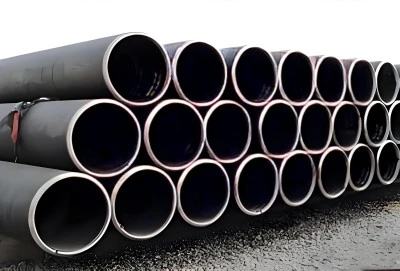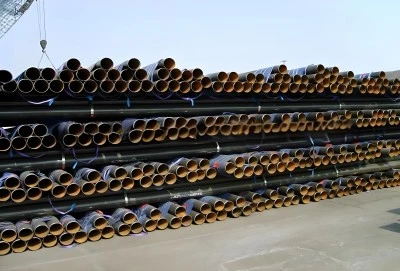API 5L X42 PSL1 pipe is a widely used material in the oil and gas industry, known for its strength and durability. However, one of its most critical properties is its corrosion resistance. In this comprehensive guide, we'll explore the corrosion resistance of X42 PSL1 pipe, its performance in various corrosive environments, protective coatings used to enhance its resistance, and best practices for maintaining its corrosion resistance.
|
|
|
Corrosion Resistance of API 5L X42 PSL1 Pipe
API 5L X42 PSL1 pipe is manufactured to meet the specifications set by the American Petroleum Institute (API). The X42 designation indicates that the pipe has a minimum yield strength of 42,000 psi, while PSL1 refers to Product Specification Level 1, which defines certain manufacturing and testing requirements.
The corrosion resistance of API 5L X42 PSL1 pipe is primarily derived from its chemical composition and manufacturing process. These pipes are typically made from low-carbon steel, which provides a good balance between strength and corrosion resistance. The steel composition usually includes small amounts of alloying elements such as manganese, silicon, and copper, which can enhance its corrosion resistance properties.
However, it's important to note that while X42 PSL1 pipe does offer some inherent corrosion resistance, it is not immune to corrosion. Its performance can vary significantly depending on the specific environmental conditions it's exposed to. Factors such as temperature, pressure, pH levels, and the presence of corrosive substances can all impact the pipe's corrosion resistance.
In general, API 5L X42 PSL1 pipe exhibits good resistance to atmospheric corrosion and performs well in environments with mild corrosivity. However, in more aggressive environments, additional protective measures are often necessary to ensure long-term integrity and performance.
Performance of API 5L X42 PSL1 Pipe in Different Corrosive Environments
The performance of API 5L X42 PSL1 pipe can vary significantly across different corrosive environments. Let's examine how this material fares in some common scenarios:
1. Atmospheric Corrosion: In standard atmospheric conditions, API 5L X42 PSL1 pipe generally performs well. The natural formation of a protective oxide layer on the surface of the steel helps to slow down the corrosion process. However, in coastal areas with high salt content in the air or industrial zones with high levels of pollutants, the corrosion rate can increase significantly.
2. Soil Corrosion: When buried underground, X42 PSL1 pipe can be subject to soil corrosion. The severity of this corrosion depends on various soil properties, including moisture content, oxygen levels, pH, and the presence of corrosive agents like chlorides and sulfates. In highly corrosive soils, additional protective measures such as cathodic protection or protective coatings are often necessary.
3. Aqueous Environments: In water-based environments, the corrosion resistance of API 5L X42 PSL1 pipe can vary widely depending on factors such as dissolved oxygen content, pH levels, temperature, and the presence of corrosive ions. In fresh water with neutral pH, the pipe generally exhibits good corrosion resistance. However, in seawater or other chloride-rich environments, corrosion rates can increase dramatically.
4. Sour Service Environments: In environments containing hydrogen sulfide (H2S), also known as sour service conditions,X42 PSL1 pipe may be susceptible to sulfide stress cracking (SSC) and hydrogen-induced cracking (HIC). These conditions are particularly challenging and often require the use of specialized materials or additional protective measures.
5. High-Temperature Environments: At elevated temperatures, the corrosion resistance of API 5L X42 PSL1 pipe can decrease. This is particularly relevant in applications such as geothermal wells or high-temperature oil and gas production. In these cases, careful material selection and additional protective measures are crucial.
It's important to note that while API 5L X42 PSL1 pipe offers moderate corrosion resistance in many environments, its performance can be significantly enhanced through the use of protective coatings and other corrosion mitigation strategies. These additional measures are often essential for ensuring the long-term integrity and safety of pipelines, especially in more aggressive corrosive environments.
Protective Coatings Used to Enhance Corrosion Resistance of API 5L X42 PSL1 Pipe
To enhance the corrosion resistance of API 5L X42 PSL1 pipe, various protective coatings are commonly employed. These coatings act as a barrier between the pipe surface and the corrosive environment, significantly extending the service life of the pipeline. Here are some of the most frequently used protective coatings:
1. Fusion Bonded Epoxy (FBE): FBE is one of the most widely used coatings for API 5L X42 PSL1 pipe. It's applied as a powder and then heated to form a continuous, tough film. FBE coatings offer excellent adhesion, good chemical resistance, and can withstand high temperatures. They're particularly effective in protecting against soil corrosion in buried pipelines.
2. Three-Layer Polyethylene (3LPE): This system consists of an epoxy primer, an adhesive layer, and an outer polyethylene layer. 3LPE coatings provide excellent mechanical protection and moisture resistance, making them ideal for buried pipelines in challenging soil conditions.
3. Three-Layer Polypropylene (3LPP): Similar to 3LPE, but with a polypropylene outer layer, 3LPP coatings offer superior resistance to high temperatures and mechanical damage. They're often used in offshore applications or in high-temperature environments.
4. Liquid Epoxy Coatings: These coatings are often used for field joints, repairs, or in situations where FBE application is not practical. They offer good corrosion protection and can be applied in various environmental conditions.
5. Polyurethane Coatings: Known for their excellent abrasion resistance and flexibility, polyurethane coatings are often used in applications where the pipe may be subject to movement or mechanical stress.
6. Zinc-Rich Primers: These primers provide cathodic protection to the steel substrate. They're often used as part of a multi-layer coating system, particularly in marine or highly corrosive industrial environments.
7. Internal Coatings: For protection against internal corrosion, various coatings such as liquid epoxies, phenolic epoxies, or nylon-based coatings may be used. These coatings can help prevent corrosion caused by the fluids being transported through the pipe.
The choice of coating depends on various factors, including the specific environmental conditions, operating temperature, installation method, and expected service life of the pipeline. In many cases, a combination of different coating types may be used to provide comprehensive protection against various corrosion mechanisms.
It's worth noting that while protective coatings significantly enhance the corrosion resistance of API 5L X42 PSL1 pipe, they are not a standalone solution. Proper application, regular inspection, and maintenance are crucial to ensure the long-term effectiveness of these coatings. Additionally, other corrosion protection methods such as cathodic protection are often used in conjunction with protective coatings for maximum effectiveness.
Best Practices for Maintaining the Corrosion Resistance of API 5L X42 PSL1 Pipe
Maintaining the corrosion resistance of API 5L X42 PSL1 pipe is crucial for ensuring its long-term performance and safety. Here are some best practices to consider:
1. Regular Inspection and Monitoring: Implement a comprehensive inspection program to detect early signs of corrosion. This may include visual inspections, non-destructive testing methods like ultrasonic testing or magnetic particle inspection, and the use of corrosion monitoring devices.
2. Proper Cathodic Protection: For buried or submerged pipelines, maintain an effective cathodic protection system. This might involve impressed current systems or sacrificial anodes, depending on the specific application and environment.
3. Coating Maintenance: Regularly inspect and maintain protective coatings. Promptly repair any damage to the coating to prevent localized corrosion.
4. Control of Internal Environment: If possible, control the internal environment of the pipe. This might involve the use of corrosion inhibitors, dehydration of transported fluids, or maintaining appropriate flow rates to minimize corrosion.
5. Proper Material Selection: Ensure that API 5L X42 PSL1 pipe is appropriate for the specific application and environment. In some cases, more corrosion-resistant grades or materials may be necessary.
6. Water Management: In oil and gas applications, effective water management is crucial. This includes proper separation of water from hydrocarbons and treatment of produced water to reduce its corrosivity.
7. Temperature Control: Where possible, maintain operating temperatures within the optimal range for corrosion resistance. High temperatures can accelerate corrosion processes.
8. pH Control: In some applications, maintaining the pH of the fluid within a specific range can help minimize corrosion.
9. Proper Welding and Joining: Ensure that all welds and joints are properly executed and inspected. These areas can be particularly vulnerable to corrosion if not properly managed.
10. Education and Training: Ensure that all personnel involved in the operation and maintenance of the pipeline are properly trained in corrosion management practices.
By implementing these best practices, operators can significantly extend the service life of API 5L X42 PSL1 pipe and minimize the risk of corrosion-related failures. However, it's important to note that corrosion management should be an ongoing process, with strategies regularly reviewed and updated based on inspection results and changes in operating conditions.
Contact Longma
X42 PSL1 pipe offers moderate corrosion resistance in many environments, but its performance can vary significantly depending on specific conditions. While it provides a good foundation for many pipeline applications, additional protective measures are often necessary to ensure long-term integrity and safety, especially in more aggressive corrosive environments.
The use of protective coatings, cathodic protection systems, and adherence to best practices in corrosion management are crucial for maximizing the service life of X42 PSL1 pipe. Regular inspection, monitoring, and maintenance are key to detecting and addressing corrosion issues before they lead to significant problems.
For those seeking high-quality API 5L X42 PSL1 pipe and expert guidance on corrosion protection strategies, Longma Group is here to help. With our extensive experience in pipe manufacturing and commitment to quality, we can provide tailored solutions to meet your specific needs. Contact us today at info@longma-group.com to learn more about our products and services, and let us help you ensure the longevity and performance of your pipeline infrastructure.














